Tele-Vue makes some of the best eyepieces in the world.
Their founder, Al Nagler, used his experience working on lunar landing simulators for the Apollo program to design some of the first high-quality Plossl eyepieces in the 1970s, followed shortly thereafter by the eyepiece design that bears his name. The Nagler eyepiece design enabled the revolution of then-new fast Dobsonian reflecting telescopes, and Tele-Vue has been leading innovation in the design of telescope eyepieces ever since.
Tele-Vue has six eyepiece series lineups along with their Nagler Zoom and specialty products like the Paracorr coma corrector, night vision eyepiece adapters, Petzval refracting telescopes, and nebula filters:
- Tele-Vue Ethos Eyepieces
- Tele-Vue Nagler Eyepieces
- Tele-Vue Delos Eyepieces
- Tele-Vue Panoptic Eyepieces
- Tele-Vue DeLite & Radian Eyepieces
- Tele-Vue Plossl Eyepieces
- Other Tele-Vue Accessories
Tele-Vue Ethos Eyepieces
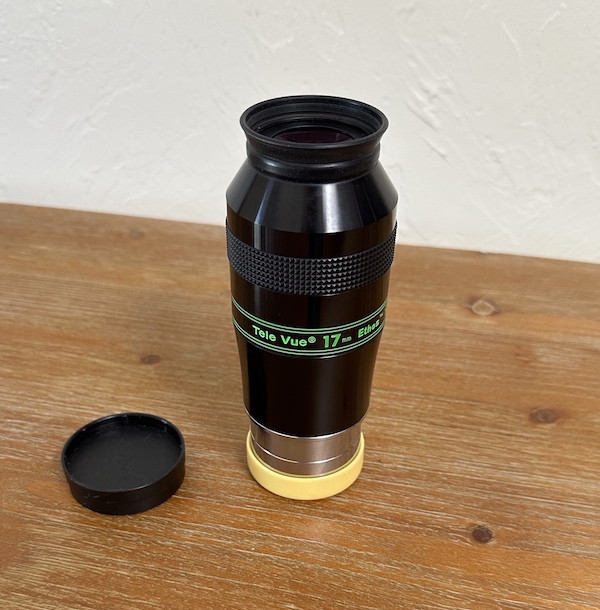
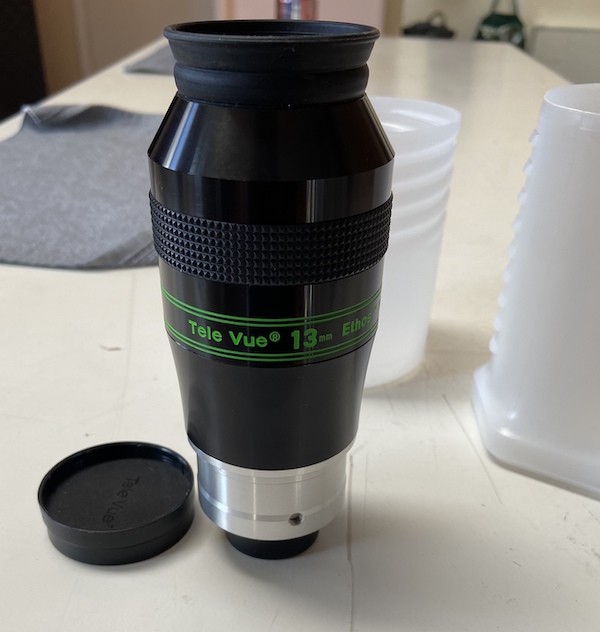
Ethos eyepieces were invented in 2007 by Al Nagler, David Nagler, and Paul Dellachiaie.
The Ethos design uses more than eight lens elements to achieve a super-sharp, well-corrected apparent field of view of 100 degrees. The 3.7mm and 4.7mm Ethos-SX eyepieces have an even wider 110-degree apparent field of view.
The 100° and 110° apparent field of view (AFOV) of the shorter focal length Ethos eyepieces make them really handy for me in telescopes without tracking, such as Dobsonians, by keeping my target in the field of view longer, as well as being extremely immersive when viewing the Moon and some large, bright deep-sky objects like the Orion Nebula.
The Ethos design has also worked well with my telescopes as fast as f/2.6 and had little in the way of aberrations besides some moderate field curvature at the longer focal lengths.
All units have a decent amount of eye relief.
Ethos Eyepiece Focal Lengths & Performances
The 21mm and 17mm Ethos eyepieces are 2” only. Even though these eyepieces have short focal lengths, I get a field of view similar to that of a typical 30mm or longer “Super Wide Angle (SWA)” or TeleVue Nagler eyepiece—yet with a wider and more immersive field of view at higher magnification. This also results in a smaller exit pupil and thus a darker background sky, making the 21mm and 17mm Ethos ideal low-power eyepieces in telescopes with fast focal ratios. In my experience, any other eyepiece with a similar true field of view produce a too-large exit pupil.
The 13mm, 10mm, 8mm, and 6mm Ethos eyepieces can be used as 1.25” or 2” eyepieces thanks to their hybrid skirt barrels. But if you want to use the 8mm or 6mm as 2″ eyepieces, you have to move your focuser a long way out or add an extension tube or barrel extension to get to focus.
The 3.7mm and 4.7mm have detachable 2” to 1.25” adapters.
Ethos eyepieces are very expensive, and as such, I’m aware that most people cannot afford the full lineup. Among the set, 13mm Ethos is probably the best TeleVue Ethos eyepiece, with the 21mm and 17mm being great for low power in faster telescopes.
You might have the idea to use the Ethos eyepieces with a Barlow lens to allow for multiple focal length options at a lower cost. But the sheer size and weight of the Ethos eyepieces make this a poor idea, in addition to other qualms we have about 2” Barlow lenses and so forth.
TeleVue Ethos Copycats
A few copycats of the Ethos exist, namely the APM/Lunt/Astro-Tech XWA series and the Explore Scientific 100° series.
The Nikon NAV-HW eyepieces are argued by some to be better than the Ethos, but they only come in two focal lengths and can have issues with spacing and back focus in certain telescopes.
From what I’ve seen, the APM XWA and derivative eyepieces largely duplicate the Ethos in function. But I’ve also noticed the 3.5mm and 4.8mm units suffering from more glare on bright objects than their Tele-Vue counterparts, and the 20mm showing some edge-of-field astigmatism in telescopes under f/4.5 focal ratio.
The Explore Scientific 100° eyepieces have oddly short eye relief, are very heavy, and none can be used in 1.25” format. The 20mm also suffers from the same flaws as the 20mm APM XWA, while the 25mm Explore Scientific 100° does not have a true 100-degree field (which is why Tele-Vue does not make the equivalent).
If you are on a budget, purchasing one or two Ethos eyepieces and completing your set with the APM XWAs is not a bad idea; I’ve done exactly that.
Tele-Vue Nagler Eyepieces
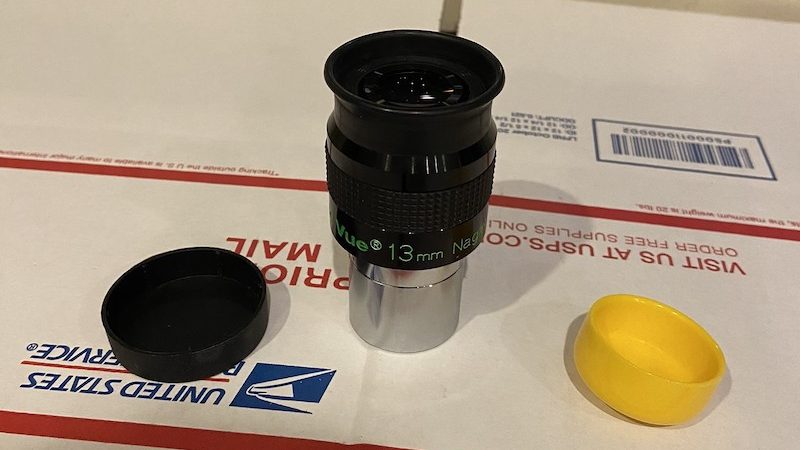
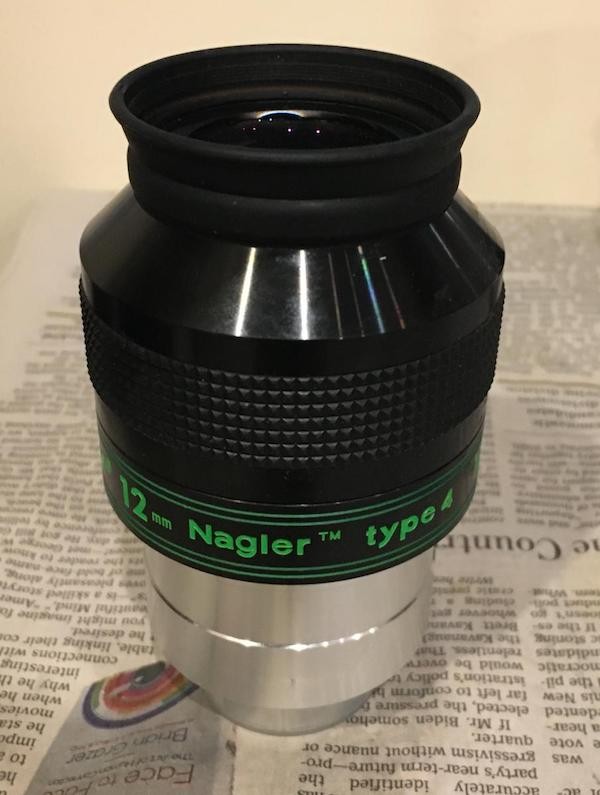
Nagler eyepieces remain Tele-Vue’s flagship product and were the first to be designed, though their Plössl line was released first to build up a reputation for the company before the Nagler’s debut.
All Nagler eyepieces feature an 82-degree apparent field of view with little in the way of distortion, field curvature, or other aberrations. They are a little easier to look through than the Ethos line and quite a bit cheaper. Naglers can be used with any telescope, even the fastest ones with a focal ratio of f/2.6 (with a coma corrector, of course).
Nagler Eyepiece Types, Focal Lengths & Performances
Over the years, the Nagler eyepieces have been iterated on with seven version updates. Four different Nagler types remain available to meet customer needs.
- The original Nagler Type 1 eyepieces were big and heavy, with poor eye relief and less-than-great correction in very fast telescopes. However, I still consider a used Nagler Type 1 eyepiece that I bought some time ago for a good price to be very good value.
- The Nagler Type 2 added a massive 2” 20mm unit and some improvements to eye placement and eye relief.
- The Type 3 was never manufactured.
- The Type 4 Naglers improved sharpness and field flatness while adding sliding eyecups to the old Type 2 design. They are still available.
- The Type 5 and Type 6 Naglers are much more lightweight and compact and feature massive improvements in eye relief, especially at the short focal length range.
- Type 7 introduced on Feb, 2025.
Available Today:
- 2″ 22 mm (Type 4)
- 1.25″ 16 mm (Type 5)
- 2″ 31 mm (Type 5)
- 1.25″ 13, 11, 9, 7, 5, 3.5 mm (Type 6)
- 2″ and 1.25″ 5.5, 2″ and 1.25″ 9, 2″ 14, and 2″ 19-mm (Type 7)
Recently Discontinued:
- 2″ 20 mm (Type 5)
- 2″ 17 mm & 12 mm (Type 4)
- 1.25″ 2.5 mm (Type 6)
The 16mm Type 5 Nagler is a great wide-field eyepiece for those limited to 1.25” focusers, as it provides lower power than something like a 13mm Ethos and a fairly wide true field of view.
The 31mm Type 5 Nagler is a favorite for users of many Dobsonians and Schmidt-Cassegrains. But I’ve noticed that 31mm’s weight can cause balance problems, and also, the exit pupil is often too large for very fast instruments, especially under light-polluted skies.
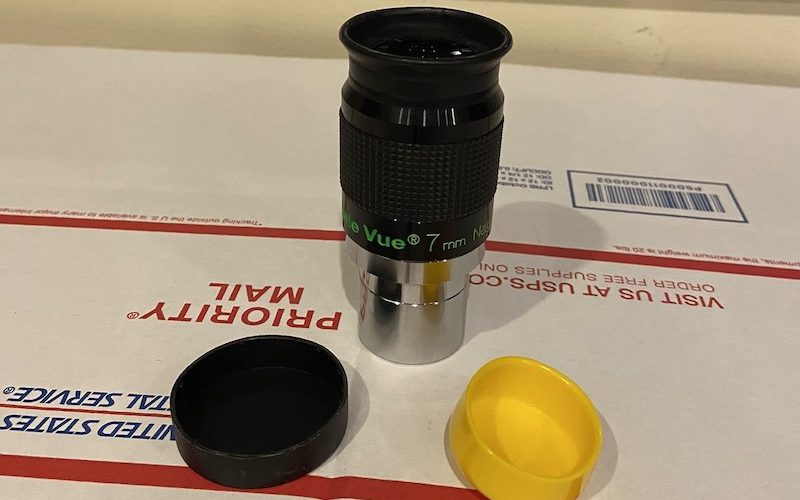
These two, along with the 7mm Type 6 Nagler, are my favorites of all of the Nagler eyepieces currently offered. Unfortunately, I haven’t gotten my hands on the newly-introduced Nagler Type 7 yet.
Unlike the Ethos eyepieces, which are simply too huge to be used with a Barlow lens, the Nagler eyepieces and their knockoffs work with a Barlow lens or Tele-Vue Powermate fairly well to achieve multiple magnification options at a lower cost, though the dedicated shorter focal length Naglers still outperform a Barlowed Nagler eyepiece.
TeleVue Nagler Copycats
Many companies have tried—and often failed—to duplicate the Nagler optical design and performance since its debut.
Until fairly recently, they rarely offered enough of an undercut in price to be worthwhile and/or didn’t even approach the Nagler design’s standards of quality and clarity, especially in fast focal ratio telescopes. Some low-quality, but still quite expensive, eyepieces, such as the oft-cited “Angelfish” 30mm, 16mm, and 11mm oculars, are merely cheap Erfles with too-wide fields and do not work well even in a very slow focal ratio telescope.
Today, the Explore Scientific 82-degree line largely duplicates the Type 5 and 6 Naglers. However, I’ve observed that some of the offered focal lengths have too-short eye relief, issues with performance in fast scopes, or odd distortions like field curvature and astigmatism.
The Celestron Luminos line suffers from similar issues and is also unusually bulky.
The Kunming United Optics Ultra Wide Angle series—offered repackaged as brands such as the Meade PWA and Astro-Tech UWA at 28mm, 16mm, 7mm, and 4mm focal lengths—is affordable and does fairly well against a real Nagler. They largely match Nagler performance even in fast telescopes, albeit with slightly worse coatings and shorter eye relief.
Tele-Vue Delos Eyepieces
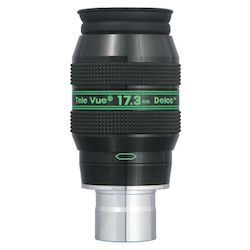
The Delos eyepieces are essentially the same optical design as Ethos eyepieces, with narrower lenses and a narrower true field of view. This makes them cheaper while having extremely long eye relief.
With an apparent field of view of 72 degrees, the Delos design gives almost perfect views with almost no aberrations at any focal ratio and in any telescope type. If you are forced to wear eyeglasses at the eyepiece due to astigmatism (though Tele-Vue sells Dioptrix correctors for that), I believe that the Delos line is probably ideal for you.
The Delos lineup consists of solely 1.25” eyepieces in 17.3mm, 14mm, 12mm, 10mm, 8mm, 6mm, 4.5mm, and 3.5mm focal lengths.
Like the Type 4 Naglers, the Delos uses a click-up eye guard: the rubber eyecup is attached to a cylindrical housing that I can slid up and down the eyepiece and lock in place for the most comfortable possible position.
Some deep-sky observers swear by the Delos line, claiming it provides slightly brighter and crisper views than an Ethos or Nagler. If you ask me, this is actually complete nonsense. The Ethos and Delos use the same number and design of lenses with identical coatings. It is physically impossible for them to be different in performance.
For the most part, I see the Delos as kind of a niche product, appealing just to people who choose to wear glasses at the eyepiece. For the same price, I’d rather get a Nagler or an Ethos knockoff, as either is going to be just as sharp with an even wider field of view. All three designs are great though; its just that a Nagler or Ethos is probably what you want.
TeleVue Delos Copycats
- The Baader Morpheus eyepiece line is optically and performance-wise very similar to the Delos design, with a slightly wider 76-degree apparent field of view.
- The Pentax XW largely duplicates the Delos in function as well, with a 70-degree apparent field and massive eye relief.
Tele-Vue Panoptic Eyepieces

The Panoptic eyepieces are slightly sharper versions of the Erfle or “SWA” design that is used in many inexpensive “wide-angle” eyepieces.
The Panoptics have an apparent field of view of 68 degrees, and I see them working their best with telescopes that have focal ratios of f/4.5 or slower.
The 24mm and 19mm units are ideal for achieving a wide field of view with binoviewers or any 1.25″ eyepiece-only small telescopes. I’ve used 41mm and 35mm Panoptics well in Dobsonian telescopes, but they often provide a too-big exit pupil when used in faster instruments. They were at their best when I used them with large Schmidt-Cassegrain telescopes, where the larger exit pupil and lower magnification compared to a Nagler or Ethos were ideal for avoiding an overly dim and too-magnified view with the huge focal length of a big f/10 SCT.
The Panoptic design does have some “pincushion” distortion, which can be distracting when attempting to move a wide-field telescope around the sky while looking through the eyepiece at the same time. Because of this and other things like exit pupil and the immersive field of view of wider-angle eyepieces, many people now prefer Nagler or Ethos eyepieces over the old Panoptic, which doesn’t have as many loyal fans as it used to.
The Explore Scientific 68-degree line duplicates the Panoptic optical design and functions, while most other eyepieces offering a similar field are inferior SWA or Erfle-type eyepieces with poorer edge-of-field correction in faster focal ratio telescopes.
Tele-Vue DeLite & Radian Eyepieces
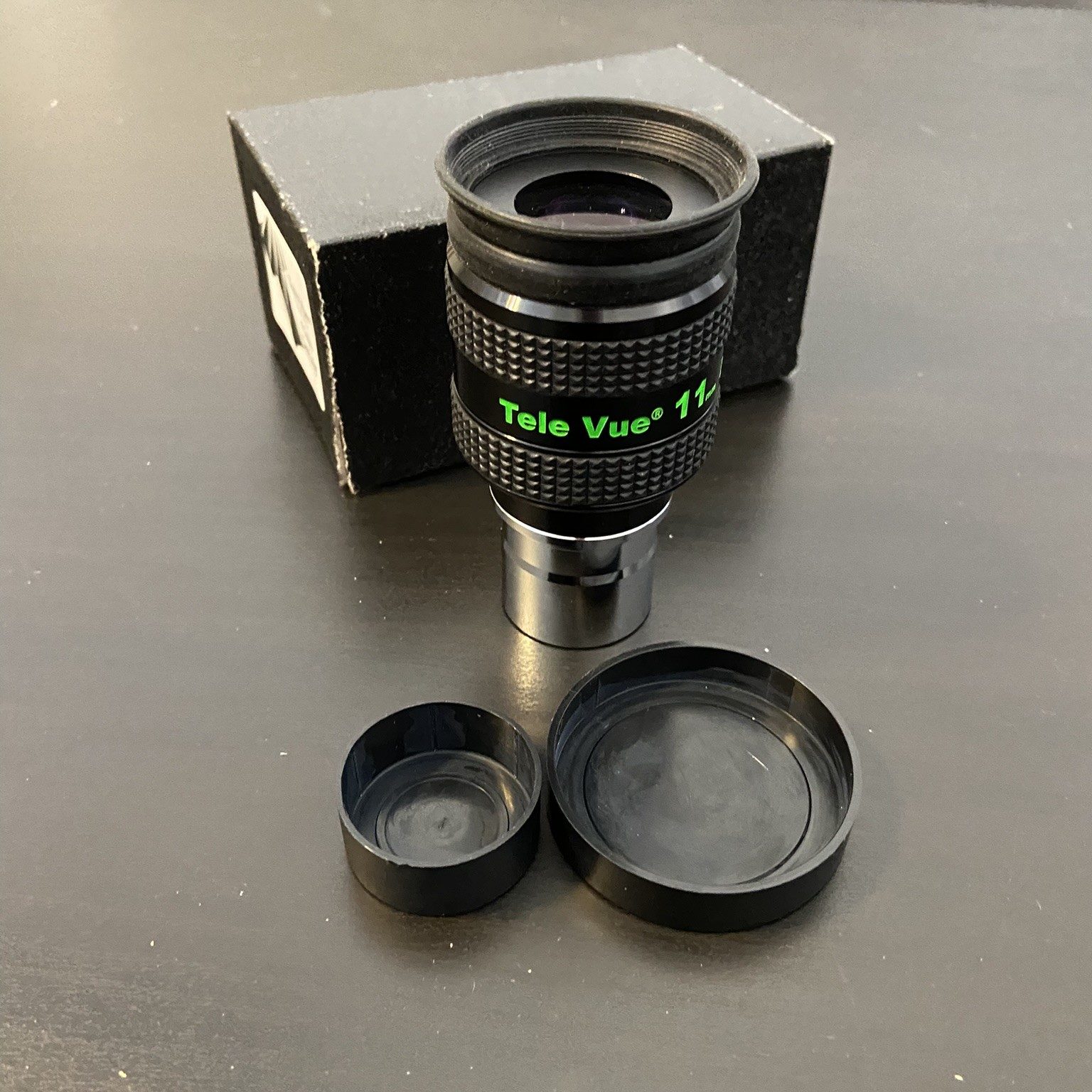
The DeLite eyepieces are a further simplification of the Delos line with a mere 62° apparent field but similarly long eye relief and the same sliding adjustable eyeguards. They are an improvement on the old Radian eyepieces, which had a 58° apparent field of view but otherwise similar features and performance.
The DeLite design is a little sharper and has less scatter than the Delos, Ethos, and Nagler eyepieces, as well as weighing and costing less. However, the apparent field of view is, of course, quite narrow. Also, the wide eye guards may cause difficulty in looking through the eyepiece for some users.
The DeLite eyepieces are offered in 18.2mm, 15mm, 13mm, 11mm, 9mm, 7mm, 5mm, 4mm, and 3mm focal lengths.
If you are using a telescope with tracking and a fast focal ratio—where well-corrected and ultra-short focal length eyepieces are required—DeLite eyepieces are probably the best possible option for planetary and double star observing. But if you don’t have tracking in your telescope, I believe you’ll want something with a wider apparent field. Slow focal-ratio telescopes don’t need short focal-length eyepieces or very high-quality optical designs to work well for viewing planets.
The DeLite and Radian designs have been duplicated by many manufacturers for “planetary” and “long eye relief” eyepieces like the BST/TMB planetary eyepieces, the Explore Scientific 62° series, the Celestron X-Cel LX, and a few others. However, whenever I compare the DeLite to its replicas, the DeLite reigns supreme, be it in its contrast, minimal scattering or ghosting, and lack of chromatic aberration.
Tele-Vue Plossl Eyepieces

Tele-Vue’s Plossl eyepieces were their original product and have not changed much since their inception. All except the 55mm have a barrel diameter of 1.25”, and all but the 40mm offer a 50-degree apparent field of view. They are made to tighter tolerances than most cheaper Plossl eyepieces, though some other manufacturers have rivaled or bested the Tele-Vue Plossl eyepieces’ performance over the years.
55mm, 40mm, 32mm, 25mm, 20mm, 15mm, 11mm, and 8mm Plossl units are offered by Tele-Vue.
- I found the 55mm to be great for night vision setups and for use in Schmidt-Cassegrain telescopes; it simply provides too low of a magnification for faster Dobsonian telescopes and many refractors.
- The 40mm and 32mm offer the same true field of view; the 40mm’s larger exit pupil may come in handy but is usually not worth the compromise of a cramped 43-degree apparent field.
- The 15mm and shorter units have short eye relief, with the 8mm being quite uncomfortable to look through to the point that I don’t really recommend purchasing.
Overall, the Tele-Vue Plossl eyepieces are great, and they beat most of the other Plossl eyepieces out there, albeit at a much higher price. Unfortunately, considering that some of the Nagler knockoffs, or at least longer eye relief and equally sharp eyepieces like the “redline” or Agena Starguider, are available at the same price, it’s hard for me to really justify purchasing a Tele-Vue Plossl eyepiece unless you are the most demanding of observers and cannot afford any of Tele-Vue’s more expensive wide-field offerings.
Other Tele-Vue Accessories
The Tele-Vue Nagler Zoom is a 1.25” zoom eyepiece with a 3-6mm focal length range and a sharp 50-degree apparent field of view. Since even a 1mm difference may be too much to handle on some nights with your telescope, the Nagler Zoom is great for telescopes with tracking, allowing you to push your telescope’s magnification to its limits and easily back off slightly when atmospheric conditions don’t allow it. A huge bonus I see is that the Nagler Zoom does not need to be refocused when we adjust its zoom setting, which is helpful especially when we’re trying to catch a brief moment of steady air.
The Tele-Vue Paracorr Type 2 is a must-have for visual use with Dobsonian telescopes with focal ratios below f/4 to f/4.5, and it’s great for deep-sky astrophotography with fast reflectors too. It corrects coma in telescopes as fast as f/2.6, without the spherical aberration or annoying spacing adjustment issues that plague other coma correctors. The Paracorr does add a 15% Barlow effect to your view, but I believe it is worth it for the tack-sharp stars it provides out to the edges of the field of view. Older Type 1 units with adjustable tops work in telescopes as fast as f/3 or so; non-adjustable Type 1s are of limited utility. Few coma correctors come close to even matching the Type 1’s performance, let alone the Paracorr Type 2.

Tele-Vue’s Barlow lenses and Powermates, available in both 1.25” and 2” formats, are great for visual or planetary astrophotography use. The Powermates provide the same magnification amplification regardless of your eyepiece/camera’s spacing, as well as better aberration control and no vignetting with wide-angle eyepieces, but the Barlows are excellent too.
Tele-Vue also makes high-quality star diagonals in 2” and 1.25” formats, namely the excellent Everbrite.
The Dioptrix astigmatism correctors can be attached to any Tele-Vue eyepiece except the Plossls and Nagler Zoom to correct for your eyes’ astigmatism, allowing you to avoid using eyeglasses that confine you to long eye relief oculars.
The Bandmate filters are rebadged Astronomik filters, which are some of the best nebula filters I’ve seen on the market.
Tele-Vue also sells a few types of red dot and reflex sights, the Sol-Searcher Sun finder, various telescope and eyepiece adapters, the FoneMate smartphone-to-eyepiece adapter, a kit for night vision eyepieces, and a line of imaging Petzval apochromatic refractors.

Yo Zane, great article dude!!
I just picked up my first TeleVue EP: a used 12mm Delos from Vlad at AVT-Astro. Of course it’s raining now lol but I’m super stoked to try it out. Hopefully it’ll become my most used DSO EP if it pans out well. (it’ll give me 100x with ~.72° TFOV and a 2mm exit pupil)
I’d love to hear the backstory of the Type 3 Naglers. I watched a interview with David Nagler that Tony Darnell from Deep Astronomy did a few years ago. When asked about them David just said “we don’t talk about those”… Someone must’ve muffed that design up big-time!!
I believe the Type 3 was just as simple as that – an abandoned design that didn’t work but clearly made it pretty far before they realized it. What scope are you using the Delos with?